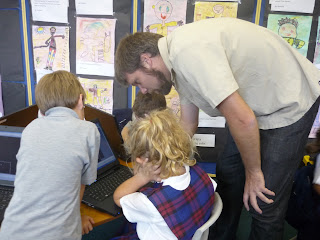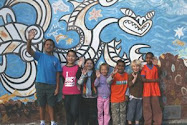Year Level: Whole School Focus
Teacher: Joan, Lisa, Louise
Focus area: Managing Self
Research Questions:
Question 1. Implementation: How effective is an interactive book as a tool for presenting students' knowledge?
Question 2. Engagement: How engaged are students when interacting with classroom laptops?
Question 3. Knowledge: (only at junior level) What makes a good park?
Question 4. Competency: How effective was the unit in developing student competency to create interactive books?
Success Criteria for Knowledge
Expert: An expert can recall, describe, retrieve, create, learn and explore through another learning area using the knowledge they have gained. They are aware of their strengths and weaknesses.
Practitioner: A practitioner can recall, describe, retrieve and create from their knowledge.
Apprentice: An apprentice can recall and describe the experience and give some detailed information that elaborates on its characteristics from one of the domains .
Novice: A novice can name, recall and label their experience with some clarity.
Learning Story:
COWS FOR RESEARCH
With the arrival of two COWS (computers on wheels) we took the opportunity to investigate the best ways we could integrate ICT and the use of these twenty laptops, into our school wide inquiry practice. A major component of this was our focus on Managing Self as our Key Competency. 'Student awareness of and ability to use key learning tools for their achievement level (eg organisation tools, process tools, thinking tools, learning habits, technology, presentation tools, etc)'

During Term 1, all syndicates were involved in EOTC experiences. The students were asked to identify an area of personal interest or curiosity that resulted from their experiences during EOTC exploration. Success criteria was developed with the students so that they were aware of the ways that they could present their findings. A student rubric for creating an interactive book was then developed.

To measure student knowledge and competency at the middle and senior level, students were asked to identify themselves on this rubric. Children at these levels had a range of abilities within the four aspects (text, sound, toolbars, content) of an interactive book that we choose to focus on. At middle and senior level, all students retained their rubric so they could refer to it as success criteria and to help them identify their next steps.
At junior level, data on individual student ability was gathered using teacher observation. This identification of student abilities gave teachers data to work from and to be able to deliver a targeted digital media facilitated programme.
As part of self management and self regulative learning, the rubric and observation allowed students to select skills they needed to develop to be successful and achieve against the set levels in the rubric.
Year 2 Class

- Session 1
Discuss with students what they know about Shorland Park
Introduce flash cards with - who what when where why how
Gather baseline information on children’s knowledge of the park Children draw or write their own ideas about what they know about Shorland Park.
On the back of the page teacher records child’s ideas
Create class chart of ideas about Shorland Park before visit
Create wall display with class chart and word cards - Session 2 Visit to park
Prior to visit tell children that they will need to visit all areas of the park and find out the names of things they do not know
At park divide class into small groups – each group lead by an adult will visit all activities at the park - Session 3
Using photos from park visit classify into different areas of the park
Children choose a photo that represents the park and write a caption for the photo - Session 4
Show children how to insert a photo into PowerPoint page and add text
Support children in finding a photo and inserting it into their page
Children add text to the photo - Session 5 (assess competency)
children find their photo
add their text to their photo
share the presentation with others - Session 6 (knowledge assessment task)
Recall what children remember about the Park
Children design their own ideal park
Provide art resources for children to create their own ideal park or park activity - Session 7
Children share their designs with other students in the school.
At the Year 2 level children were scaffolded by creating a template page for students to place their picture and text into, allowing time for them to explore finding and inserting pictures, and allowing time for them to explore working with text. A high adult to student ratio of 1:8
was used. At this level one presentation was created by the whole class with individual students contributing one page each.
Results:
Asked questions - 3.2
Listened to and thought about other's ideas and responded respectfully - 3.3
Used positive body language related to task - 3.7
Persevered in order to enact related task - 3.8
Showed evidence of being active learners outside school time - 3.0
Showed interest in directing their own learning - 2.3
Had behavioural issues that impacted on their learning - 1.2
Showed evidence of using what they have learnt - 2.3
Overall mean level of engagement of students = 3.3
Asked questions - 2.9
Listened to and thought about other's ideas and responded respectfully - 3.4
Used positive body language related to task - 4.5
Persevered in order to enact related task - 4.9
Showed evidence of being active learners outside school time - 3.8
Showed interest in directing their own learning - 4.1
Had behavioural issues that impacted on their learning - 1.7
Showed evidence of using what they have learnt -4.9
Offered ideas - 3.4
Asked questions - 2.6
Listened to and thought about other's ideas and responded respectfully - 4.0
Used positive body language related to task -4.8
Showed evidence of being active learners outside school time -2.9
Showed interest in directing their own learning -3.3
Had behavioural issues that impacted on their learning - 1.4
Showed evidence of using what they have learnt - 4.0
Overall mean level of engagement of students = 3.8
Number of students who were ...
7. Beginning experts - at start 0; at end 0
6. Proficient practitioners - at start 0; at end 3
5. Beginning practitioners - at start 0; at end 2
4. Proficient apprentices - at start 0; at end 17
3. Beginning apprentices - at start 0; at end 2
2. Proficient novices - at start 7; at end 0
1. Beginning novices - at start 17; at end 0
7. Beginning experts - at start [0; at end [0]
6. Proficient practitioners - at start [0; at end [4]
5. Beginning practitioners - at start [2]; at end [11]
4. Proficient apprentices - at start [4; at end [4]
3. Beginning apprentices - at start [4]; at end [3]
2. Proficient novices - at start [11]; at end [3]
1. Beginning novices - at start [6]; at end [2]

Year 5/6 students
Number of students who were ...
- a new technology in the school
- an ICT facilitator
- easy and immediate access to instant research through www
Question 3. Knowledge: (only at junior level) What makes a good park?















No comments:
Post a Comment